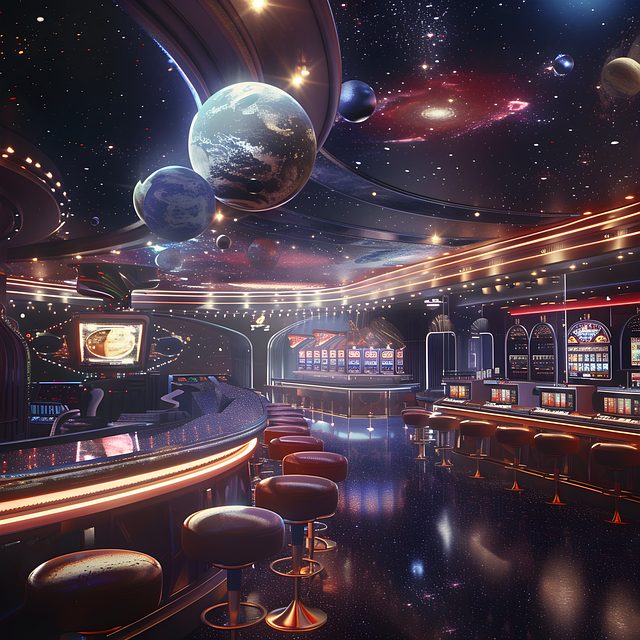Brick and mortar casinos have a centuries-old history, evolving from exclusive 19th-century spaces to widespread resort destinations by the mid-20th century. During the industry's Golden Age, they thrived as vibrant social hubs, driving innovation in gaming and technology. Today, these iconic landmarks adapt to digital trends by integrating mobile apps while addressing responsible gambling through stringent measures. Despite online gambling's rise, brick and mortar casinos remain unique atmospheric experiences for people from all walks of life.
Explore the captivating journey of Brick and Mortar Casinos, tracing their origins back to ancient civilizations and observing their evolution into grand gambling hubs. From the decadent Golden Age that shaped iconic destinations, to the present day, where technology challenges traditional gaming, this article delves into the dynamic history and enduring allure of brick-and-mortar casinos. Uncover the milestones, cultural impacts, and adaptations that continue to define the landscape of land-based gambling.
- Origins and Evolution of Brick and Mortar Casinos
- Golden Age and Rise of Land-Based Gambling Hubs
- The Modern Era: Changes and Challenges for Brick and Mortar Casinos
Origins and Evolution of Brick and Mortar Casinos

The origins of brick and mortar casinos can be traced back centuries, with the first known forms of gambling emerging in ancient civilizations like Greece and Rome. However, the modern casino as we know it today began to take shape during the 19th century, particularly in Europe and the United States. These early establishments were often luxurious and exclusive, catering to high-rolling individuals and serving as social hubs for the elite. The term “Brick and Mortar” itself refers to these physical buildings with tangible structures, contrasting with the digital realm of online gambling that emerged later.
Over time, brick and mortar casinos evolved to become more widespread and accessible. They became integral parts of resort destinations, offering not just games of chance but also entertainment, dining, and accommodation. This evolution marked a significant shift in the casino industry, transforming it from hidden speakeasies to vibrant, bustling venues that attract folks from all walks of life. Today, these casinos continue to be iconic landmarks, fostering a unique atmosphere where people gather to take their luck into their own hands.
Golden Age and Rise of Land-Based Gambling Hubs

During the mid-20th century, the gambling industry experienced a Golden Age marked by the rise of land-based casinos as popular entertainment hubs. This era saw the establishment of iconic brick and mortar gambling destinations that attracted visitors from all walks of life. These casinos offered more than just games of chance; they became centres of social interaction, luxury, and entertainment, complete with elaborate decor, live performances, and fine dining experiences. The success of these physical venues laid the foundation for the industry’s growth and evolution.
The popularity of brick and mortar casinos sparked a competition that led to innovative gaming concepts, enhanced customer experiences, and technological advancements. As gambling became more regulated, these land-based hubs had to adapt to stay relevant. They embraced new trends, such as themed gaming floors, interactive slot machines, and high-stakes poker rooms, ensuring their position as top destinations for both casual and avid gamblers alike.
The Modern Era: Changes and Challenges for Brick and Mortar Casinos

The late 20th and early 21st centuries have brought significant changes to the landscape of brick-and-mortar casinos, reflecting broader societal shifts towards digital entertainment. With advancements in technology, online gambling platforms have emerged as formidable competitors, offering players convenience, accessibility, and a vast array of games from the comfort of their homes. This has forced traditional casinos to adapt and evolve to stay relevant. Many have embraced the digital revolution by integrating online gaming features, such as mobile apps, into their establishments, allowing patrons to seamlessly transition between land-based and virtual experiences.
Casinos also face new challenges in an era where responsible gambling initiatives are gaining prominence. There’s a growing awareness of problem gambling issues, leading to stricter regulations and measures to protect vulnerable individuals. Brick-and-mortar casinos are responding by implementing sophisticated age verification systems, promoting responsible gaming through educational campaigns, and offering support services for those struggling with addiction. This evolution ensures that while the industry adapts to digital trends, it also maintains a safe and enjoyable environment for its patrons.
The journey of brick and mortar casinos reflects a captivating evolution in the gambling industry. From their humble origins to becoming vibrant, bustling hubs, these establishments have left an indelible mark on both the economic landscape and social fabric of many communities. However, as we navigate the modern era, the challenges posed by the digital realm prompt an inevitable transformation. The future of brick and mortar casinos lies in adapting to changing consumer preferences while preserving the unique experiences that have defined them for centuries.






